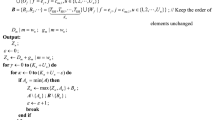Abstract
The requirements made on industry, and particularly on development departments, are increasing constantly due to demands to reduce costs and development times and the introduction of new quality guidelines (Toutenburg and Gössl, Versuchsplanung in der industrie; moderne methoden und softwarelösungen. Proceedings des workshops versuchsplanung in der industrie der boehringer mannheim GmbH und SAS-Institute, Tutzing 30./31.10.1995. Prentice Hall Verlag, München, 1996). In particular, several loops are usually required within the development process during the development of new parts to obtain an optimal part shape. This process is extensively influenced by the experience and know-how of the developer or design engineer. A method that enables a specific and structured approach to part shape optimisation is presented in this paper. Design of experiments and the finite element method are interlinked in this method.
Similar content being viewed by others
References
Barthelemy J-FM, Haftka RT (1993) Approximation concepts for optimum structural design—a review. Struct Optim 5:129–144
Bathe K-J (2000) Finite Elemente Methoden. Springer, Berlin
Deger Y (2001) Die methode der finiten elemente; Grundlagen und Einsatz in der Praxis. Expert Verlag, Renningen
Bhavikatti SS, Ramakrishnan CV (1980) Optimum shape design of rotating disks. Comput Struct 11:397–401
Box GEP, Hunter WG, Hunter JS (1978) Statistics for experiments. Wiley, New York
Dedmon SL, Pilch JM (2001) Design optimization of a freight car wheel. Railroad Conference, 2001. Proceedings of the 2001 IEEE/ASME Joint
Ebrahimi ND, Slavin AD (2002) Optimization of flywheels and rotating disks. American Institute of Aeronautics and Astronautics (AIAA-2002-0721)
Fröhlich P (2005) FEM-Anwendugspraxis; Einstieg in die Finite Elemente Analyse, zweisprachige Ausgabe Deutsch/Englisch. Vieweg Verlag, Wiesbaden
Hastie T, Tibshirani R, Friedmann J (2001) The elements of statistical learning; data mining, inference, and perdiction. Springer series in Statistics, New York
Kermelk W (1999) Fahrzeugräder: Aufbau, Konstruktion und Testverfahren. Verlag Moderne Industrie, Landsberg
Klein B (1997) Grundlagen und Anwendungen der Finite-Elemente-Methode. Vieweg Verlag, Braunschweig
Kleppmann W (2003) Taschenbuch der Versuchsplanung. Carl Hanser Verlag, München
Kok S, Stander N (1999) Optimization of a sheet metal forming process using successive multipoint approximations. Struct Optim 18:277–295
Krebs R (1996) Optimierung des Tiefziehprozesses mit Methoden der Statistischen Versuchsplanung. Dissertation der Universität Siegen
Kuehl RO (2000) Design of experiments: statistical principles of research design and analysis. Duxbury Press, Pacific Grove
Lautenschlager U (1999) Robuste Multikriterien-Strukturoptimierung mittels Verfahren der Statistischen Versuchsplanung; Anwendung auf Gestaltoptimierungsprobleme. Dissertation der Universität Siegen. Forschungszentrum für Multidisziplinäre Analysen und Angewandte Strukturoptimierung. FOMAAS, Siegen
Markine VL, Shevtsov IY, Esveld C (2007) An inverse shape design method for railway wheel profiles. Struct Multidisc Optim 33:243–253
Meske R, Sauter J, Schnack E (2005) Nonparametric gradient-less shape optimization for real-world applications. Struct Multidisc Optim 30:201–218
Meywerk M (2002) Optimization in automotive industry: methods and applications. VDI-Tagung Berechnung und Simulation im Fahrzeugbau vom 01./02.10.2002 in Würzburg
Montgomery DC (2000) Design and analysis of experiments. Wiley, New York
Müller CH (1997) Robust planning and analysis of experiments. Springer, New York
Müller G, Groth C (1997) FEM für Praktiker: die Methode der Finiten Elemente mit dem FE-Programm ANSYS. Expert Verlag, Renningen
Müller R (1978) Statistische Versuchsplanung Grundsätze und praktische Möglichkeiten bei geringem Versuchsaufwand. ZwF 73:51–54
Nielsen JCO, Fredö CR (2005) Multi-disciplinary optimization of railway wheels. J Sound Vib 293:510–521
Petersen H (1991) Grundlagen der Statistik und der Statistischen Versuchsplanung. Ecomed, Landsberg
Redhe M, Nilsson L (2006) A multipoint version of space mapping optimization applied to vehicle crashworthiness design. Struct Multidisc Optim 31:134–146
Roux WJ, Stander N, Haftka RT (1998) Response surface approximations for structural optimization. Int J Numer Methods Eng 42:517–534
Shang R, Altenhof W, Hu H, Zheng C, Li N (2006) A post-processor for finite element stress-based fatigue analysis. SAE Int, pp 9-15
Schoofs AJG, Klink MBM, van Campen DH (1992) Approximation of structural optimization problems by means of designed numerical experiments. Struct Optim 4:206–212
Taguchi G, Wu Y (1985) Introduction to offline quality control. Central Japan Quality Control Assc., Nagaya
Toropov VV (1989) Simulation approach to structural optimization. Struct Optim 1:37–46
Toropov VV, Filatov AA, Polynkin AA (1993) Multiparameter structural optimization using FEM and multipoint explicit approximations. Struct Optim 6:7–14
Toutenburg H (2000) Induktive Statistik. Springer, Berlin
Toutenburg H, Gössl R (1996) Versuchsplanung in der Industrie; Moderne Methoden und Softwarelösungen. Proceedings des Workshops “Versuchsplanung in der Industrie” der Boehringer Mannheim GmbH und SAS-Institute, Tutzing 30./31.10.1995. Prentice Hall Verlag, München
Venter G, Haftka RT, Starnes Jr JH (1998) Construction of response surface approximations for design optimization. AIAA J 36(12):2242–2249
Weinert M (1994) Sequentielle und parallele Strategien zur optimalen Auslegung komplexer Rotationsschalen. Dissertation der Universität Siegen. Forschungszentrum für Multidisziplinäre Analysen und Angewandte Strukturoptimierung. FOMAAS, Siegen
Wittmann H (2000) Design of experiments zur Untersuchung von Ladungswechselberechnungen. In: Berechnungen und Simulationen im Fahrzeugbau. Paper zum 10-ten internationalen Kongress - Berechnung im Fahrzeugbau vom 14./15.09.2000 in Würzburg. Düsseldorf: VDI, pp 597–614
Zienkiewicz OC (2005) The finite element method. Butterworth-Heinemann, Oxford
Author information
Authors and Affiliations
Corresponding author
Rights and permissions
About this article
Cite this article
Schäfer, C., Finke, E. Shape optimisation by design of experiments and finite element methods—an application of steel wheels. Struct Multidisc Optim 36, 477–491 (2008). https://doi.org/10.1007/s00158-007-0183-6
Received:
Revised:
Accepted:
Published:
Issue Date:
DOI: https://doi.org/10.1007/s00158-007-0183-6




